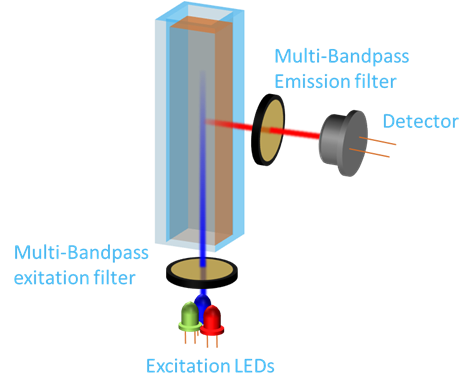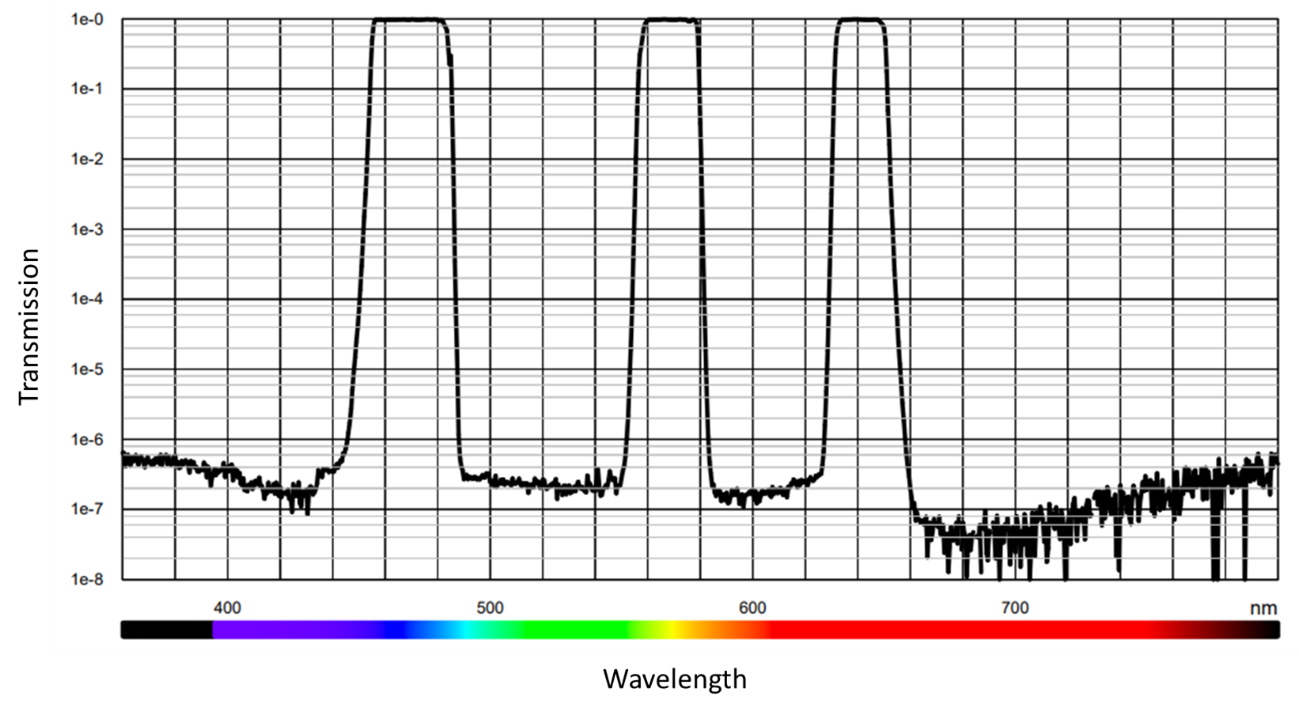Simplify your fluorometer with multi-bandpass filters
Multi-Bandpass Filters for fluorescence
Introduction
Fluorescence spectroscopy is a powerful technology used extensively in life science instruments to measure chemical reactions in biological materials. Examples of applications are DNA sequencing and viral screening using for instance Polymerase Chain Reaction (PCR) methods.
Target molecules are tagged with a fluorophore that, once bound to the target, emits light at a specific wavelength when excited with light at a lower wavelength. Optical filters are commonly used to ensure that the sample is excited with the right wavelength and the detector measures at the right emission wavelength only.
Many instrument manufacturers offer compact instruments dedicated to a specific use case (and fluorophore) with a fixed excitation and emission wavelength. However, end-users in laboratories, clinics and hospitals desire multi-purpose instruments rather than one instrument per use case. This often requires the same instrument to handle multiple excitation and emission wavelength.
For more advanced reactions involving two or more different target molecules in the same sample, each target molecule is tagged with a different fluorophore. The different fluorophores are typically chosen with different excitation and emission wavelengths and thus the instrument must be able to handle this.
In this technical note we describe how multi-bandpass filters can be used to create compact, simple, and cost-effective instruments supporting multiple excitation and emission wavelength bands.
Instrumentation with multiple excitation and emission wavelengths
A common design to handle multiple excitation and emission wavelengths is shown on Figure 1 The excitation is done with Light Emitting Diodes (LEDs) that are switched on one at a time. Each LED has a specific center wavelength corresponding to the peak absorption of a specific fluorophore. The spectrum of an LED is typically quite broad and therefore an excitation filter is used to “clean up” the spectrum as illustrated on Figure 2. The excitation filter furthermore helps to suppress unwanted ambient light outside the excitation band. For each LED wavelength we need a specific excitation filter and therefore, the filters are typically placed on a wheel that can be turned by a motor or by hand. In this way the excitation filter and LED wavelength can be matched.
Similarly, on the emission side we expect three different emission bands depending on which LED is turned on. For this reason, a second filter wheel with three filters are used on the emission side.
The optical requirements for the filters are a high pass-band transmission, a deep blocking outside the pass-band and a narrow transition wavelength range between the two.
Although, the filter-wheel approach just described allows analysis of multiple fluorophores it has some limitations and disadvantages. First, changing filter naturally takes some time. This can be a limitation for instance in real-time analysis of reaction kinetics where multiple emission peaks must be measured over time. Second, the color-wheel is a moveable mechanical item which requires more space and – in case it is motorized – power than a single fixed filter. Also, a moveable item experiences wear and tear over time.
Multi-Bandpass filters solve many of the challenges mentioned above by incorporating multiple pass-bands in a single fixed filter. This leads to a much simpler instrument design as illustrated in Figure 3 and is especially beneficial for compact instruments as well as instruments for fast reaction kinetics.
Cost-effective manufacturing of multi-Bandpass filters with 2 to 3 pass-bands on the same substrate has been made possible using modern optical thin film coating techniques. Hereby, hundreds of thin-film layers can be deposited on a substrate to form the exact filter profile needed for a specific application.
Multi-Bandpass Filters from Delta Optical Thin Film
Delta Optical Thin Film manufactures high performance, hard coated multi-bandpass filters. Figure 4 shows an example of a filter, we have manufactured with three passbands. The transmission in the passbands is typically better than 95 % and the blocking in between the bands is higher than OD6.
You can find more details about our Multi-Bandpass filters here.
If the filters listed do not match your exact requirements, you can always contact Delta Optical Thin Film if you need a customized design.
Stay updated on our expert insights
Get the latest news and insights about optical filters – subscribe to our newsletter.




